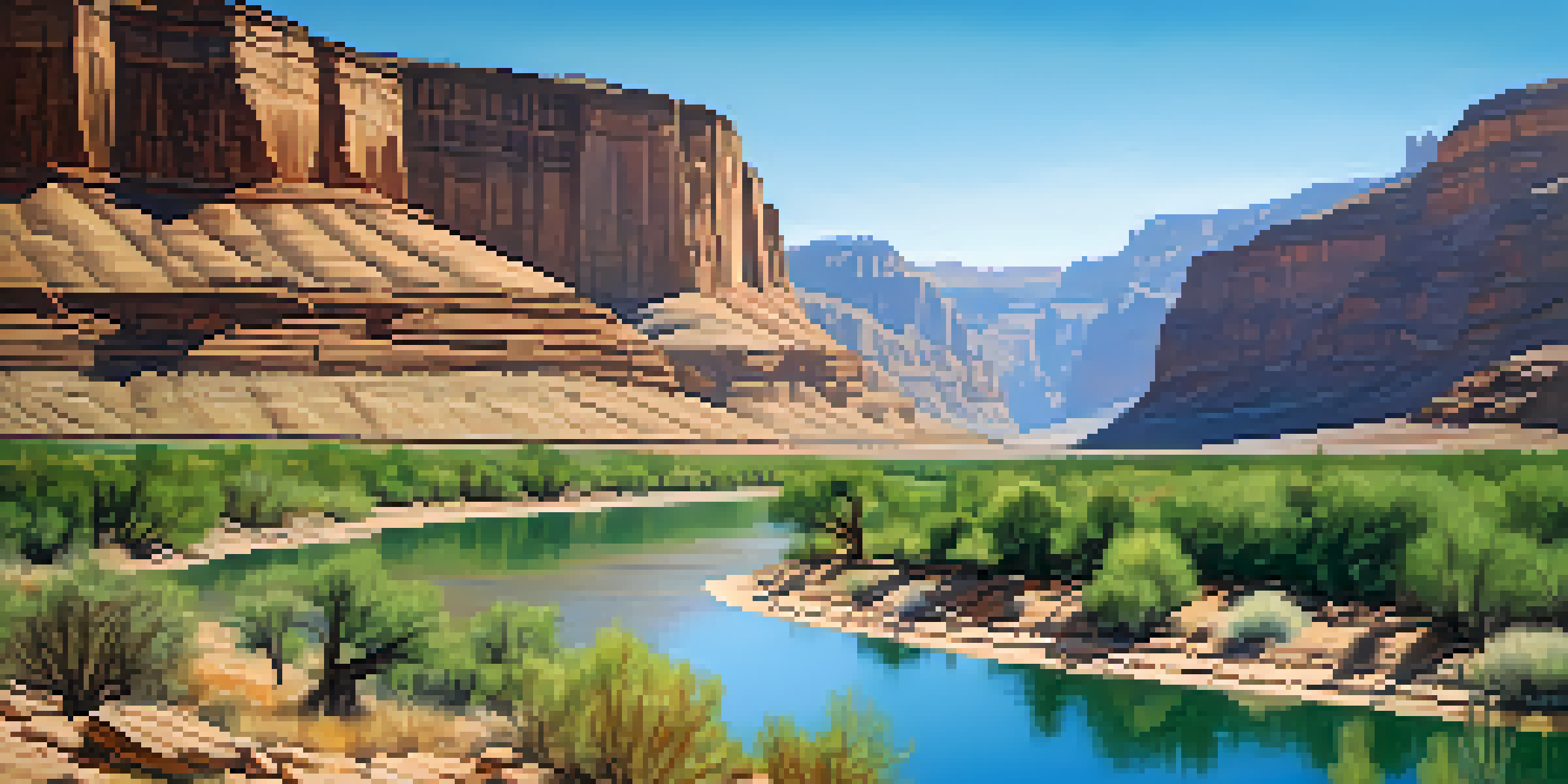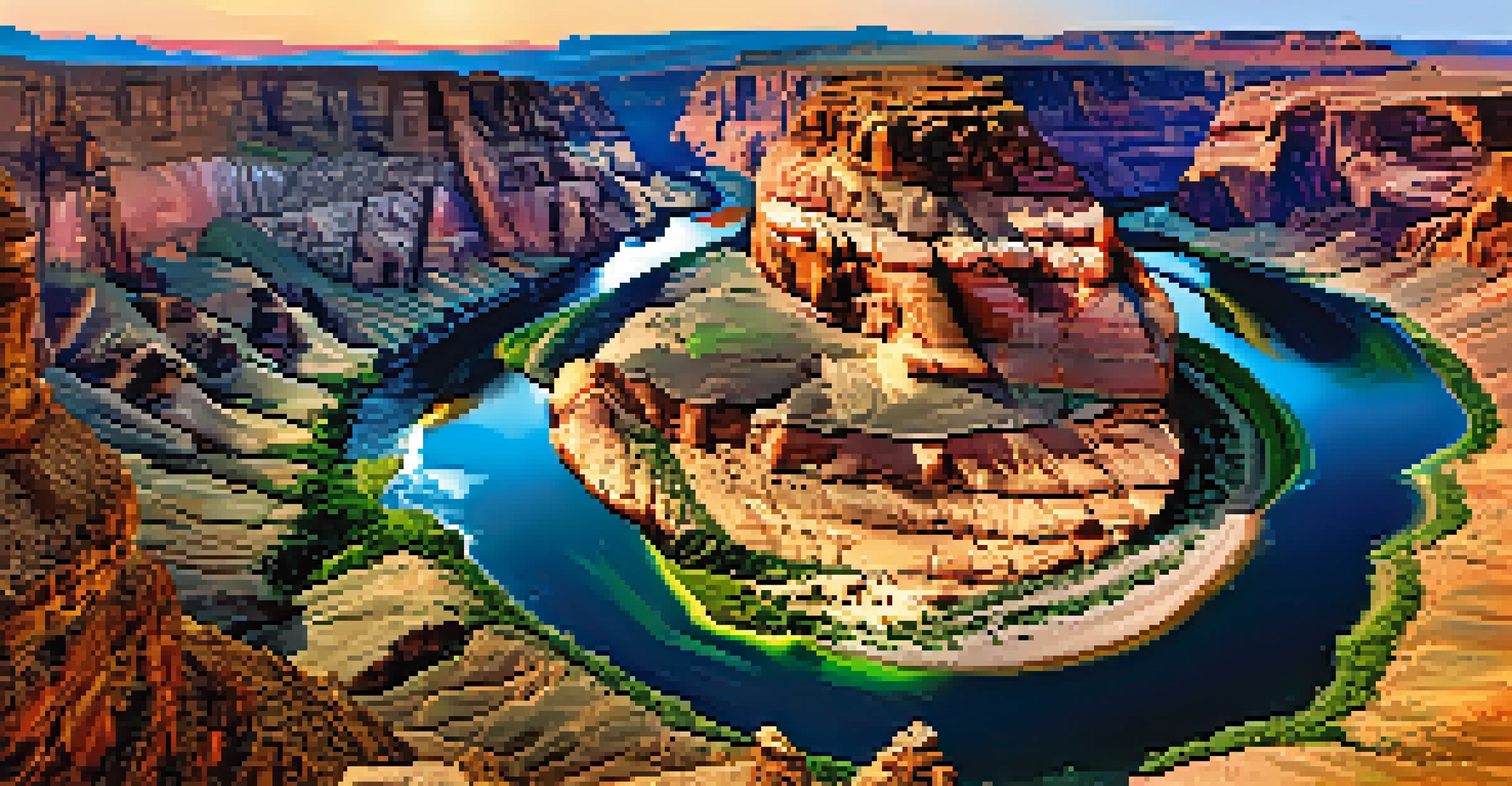Rivers of Utah: Shaping the State's Geography and Ecosystems

Overview of Utah's River Systems and Geography
Utah is home to a complex web of rivers that play a crucial role in shaping its geography. These rivers carve through mountains, create valleys, and form canyons, influencing everything from soil composition to vegetation. For instance, the Colorado River not only outlines the state’s southern border but also contributes to iconic landscapes like the Grand Canyon.
Rivers are the arteries of our planet; they are the lifeblood of our ecosystems, nourishing the land and supporting countless species.
The state’s rivers, including the Bear, Jordan, and Green Rivers, each have unique features that contribute to Utah’s diverse topography. They serve as lifelines for the surrounding ecosystems, providing essential water sources for plants and animals. Additionally, rivers help define the climate of different regions, with their presence often leading to more fertile lands.
Understanding the geography of Utah involves recognizing how these waterways interact with the surrounding environment. From the high mountain streams that originate in the Wasatch Range to the meandering rivers in the low desert areas, each river has its own story of erosion and deposition that contributes to the state's overall landscape.
The Role of Rivers in Utah's Ecosystems
Rivers are vital to the ecosystems they flow through, acting as habitats for numerous species of flora and fauna. The water they provide supports diverse plant life along their banks, creating lush riparian zones that contrast with the arid landscapes typical of much of Utah. These areas are rich in biodiversity, hosting birds, fish, and mammals that rely on the river for survival.

For example, the Bear River is crucial for migratory birds, serving as a stopover point during their long journeys. The wetlands created by the river’s floodplains provide nesting grounds and food sources, showcasing how rivers can enhance local biodiversity. In this way, rivers act not just as geographical features but as hubs of life that sustain various ecosystems.
Rivers Shape Utah's Geography
Utah's rivers, including the Colorado and Bear Rivers, significantly influence the state's landscape, ecosystems, and climate.
Moreover, Utah's rivers help maintain ecological balance by supporting nutrient cycling. As water flows through these systems, it transports sediments and organic matter, enriching the surrounding soil and promoting healthy plant growth. This natural process underscores the interconnectedness of rivers with the broader ecological fabric of the state.
Impact of Climate on Utah's Rivers
Utah's rivers are significantly influenced by the state's arid climate, which presents both challenges and opportunities. The limited precipitation means that river flows can vary dramatically depending on the season. During spring, snowmelt from the mountains can lead to swollen rivers, while summer's heat can cause streams to dwindle.
The health of our rivers is critical to the health of our communities, and we must work together to protect these vital resources.
This fluctuation impacts not only the ecosystems that depend on consistent water sources but also human activities like agriculture and recreation. Farmers rely on river water for irrigation, and changes in flow can affect crop yields. Additionally, recreational activities such as fishing, rafting, and kayaking are closely tied to river conditions, making climate patterns a crucial consideration.
Understanding how climate affects river systems is essential for managing water resources in Utah. As climate change continues to alter weather patterns, the implications for rivers and their surrounding ecosystems become increasingly important. This awareness can help inform conservation efforts and ensure that these vital waterways are preserved for future generations.
The Historical Significance of Rivers in Utah
Rivers in Utah have a rich history that dates back thousands of years, serving as essential routes for early Native American tribes. These waterways provided not only water but also fish and game, making them central to the survival of these communities. The historical significance of rivers extends beyond sustenance; they were also vital for trade and communication between tribes.
With the arrival of European settlers, rivers became crucial for transportation and agricultural development. The Mormon pioneers, for instance, utilized rivers for irrigation to transform the arid landscape into productive farmland. This historical reliance on rivers has shaped Utah's development and settlement patterns, highlighting their importance in shaping the state's culture and economy.
Climate Challenges Affect Water Flow
The arid climate of Utah causes seasonal fluctuations in river flows, impacting both ecosystems and human activities like agriculture.
Today, many of these historical waterways are recognized and protected for their cultural significance. Efforts to preserve the natural and historical integrity of rivers reflect a growing appreciation for their role in Utah’s heritage. This legacy underscores the enduring impact of rivers on the state’s identity.
Current Challenges Facing Utah's Rivers
While Utah's rivers continue to be vital for ecosystems and human activities, they face numerous challenges. Urbanization, agricultural demands, and climate change put significant pressure on these waterways, often leading to decreased water quality and quantity. Pollution from runoff and industrial activities can harm aquatic life and disrupt delicate ecosystems.
Additionally, water over-extraction for irrigation and recreation can lead to reduced river flows, affecting not just wildlife but also the communities that rely on these resources. As demand for water increases, especially in arid regions like Utah, finding a balance between human needs and environmental health becomes increasingly difficult.
Addressing these challenges requires community involvement and innovative management strategies. Local conservation efforts and sustainable practices can play a crucial role in protecting river ecosystems. By raising awareness and advocating for responsible water use, residents can help ensure that Utah's rivers continue to thrive for generations to come.
Conservation Efforts for Utah's Rivers
In response to the challenges facing its rivers, Utah has implemented various conservation initiatives aimed at protecting these vital resources. Organizations like the Utah Rivers Council work tirelessly to promote awareness and advocate for sustainable river management practices. Their efforts focus on restoring degraded river habitats and improving water quality.
Community involvement is crucial to the success of these conservation efforts. Local volunteer groups often participate in river clean-up events and habitat restoration projects, fostering a sense of stewardship among residents. These grassroots efforts not only help improve river health but also strengthen community ties.
Conservation is Key for Future Rivers
Active conservation efforts and community involvement are essential to protect Utah's rivers and sustain their ecosystems amidst growing challenges.
Education plays a critical role in conservation as well. By informing the public about the importance of rivers and how to protect them, Utah's conservation organizations aim to inspire future generations to value and care for their local waterways. This collective responsibility is essential for ensuring the longevity of Utah's rivers and the ecosystems they support.
The Future of Utah's Rivers and Ecosystems
Looking ahead, the future of Utah's rivers hinges on proactive management and conservation efforts. As climate change continues to impact water availability, it will be crucial to adopt innovative solutions that prioritize sustainability. This may include practices such as water recycling, improved irrigation techniques, and the restoration of natural river flows.
Furthermore, collaboration among stakeholders, including governmental agencies, local communities, and conservation organizations, will be key to developing effective strategies for river management. By working together, these groups can create policies that balance ecological health with human needs, ensuring that rivers remain vibrant and productive.

Ultimately, the future of Utah's rivers is a collective responsibility. By fostering a culture of respect and care for these waterways, Utahns can help ensure that future generations inherit a healthy and thriving ecosystem. The rivers of Utah are not just vital resources; they are a testament to the state's rich natural heritage and a promise of life for the future.